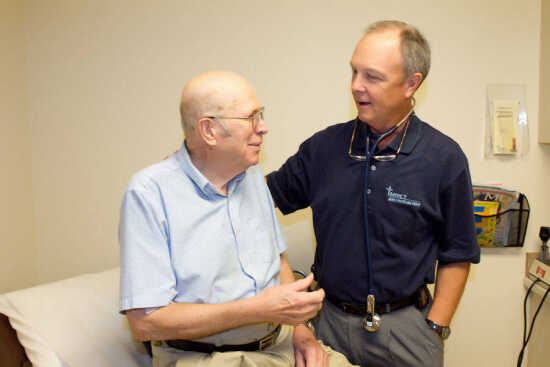Mercy: 125 years of strength and stability

Editor's note: This is the second of five weekly articles reflecting on Mercy's health care ministry in southeast Kansas
In 1886, Fort Scott's Mercy Hospital opened, staffed by two Sisters and two lay women. Today, 125 years later, Mercy is the largest employer in Bourbon County. The hospital averages 2,000 admissions per year, sees more than 7,000 emergency room visits and employs more than 400 co-workers who consider health care their calling.
"Mercy is one of those strong, time-tested pillars in our community," Fort Scott City Manager Dave Martin said. "Not only are they responsible for healing bodies and souls, but they are an economic strength through their committed professional associates and involvement in the community."
When it comes to caring for people's health, Mercy can boast a retention rate among physicians and co-workers that is nearly double the national average. In fiscal year 2011, Mercy's turnover rate was a mere 1.41 percent; half the national rate of 2.9 percent as published by the U.S. Bureau of Labor Statistics.
More than half of Mercy's physicians have practiced at Mercy for more than 13 years with three of those practicing at Mercy for 30 years or more.
"I am doubly blessed to have not only been able to serve the people of this area for over 30 years but also to have had the support of Mercy's staff, leadership and recourses," Vice President of Medical Affairs Dr. Randy Nichols said. "Although Mercy is a forward-thinking, nationally-recognized health care system, it remains grounded in quality and compassionate care."
The right physician can make all the difference in a patient's life, as in this story told by Gordon Parks about Dr. Gordon Baldwin, Mercy Hospital's first physician.
"I was born dead. But a young white doctor plunged my blood-soaked remains into a tub of icy water and miraculously gave me life. With determination he had disallowed even death to defeat me. Years later, when told about the event by an older sister, I went to give him my thanks. But by then he was dead. My mother had expressed her gratitude to him by giving me his name. Dr. Gordon was the savior whose color had nothing to do with his giving me, a Black child, a right to life." -- Excerpt from "A Hungry Heart," a Gordon Parks autobiography.
Supporting physicians are many other Mercy clinicians and co-workers who have committed their life's work to caring for the health of others. More than 11 percent of Mercy's 407 Fort Scott co-workers have 25 years or more of service at Mercy and the majority of obstetric and neonatal intensive care nurses have more than 20 years of experience.
Mercy co-workers are invested in the service they provide, but they take great pride in providing the most advanced health care.
In October 2008, Mercy Hospital in Fort Scott stepped into a new era of health record documentation and management called the electronic health record (EHR), long before federal government mandates and most other health care organizations.
Although Mercy Hospitals in Fort Scott and Independence had been using electronic documentation for many years, the implementation of the EHR system created a single electronic record for each patient, and gives providers computerized tools to document care, order medications and tests and review results. Mercy now is among an elite group of only three percent of all health care organizations in the U.S. that have such a complete and comprehensive electronic health record system in place.
The EHR gives Mercy's medical providers -- regardless of geographical location in the Sisters of Mercy Health System -- access to critical patient information such as prescriptions, medication allergies and other vital data that may save a patient's life.
"The investment in installing the EHR at Mercy was significant; in personnel and financial resources," said Mercy Health Center President/CEO Reta Baker. "Every co-worker received hands-on training, often upwards of 40 hours. It was a challenge to meet the timelines, the goals and the expectations to be prepared for our go-live date."
"We were embarking in new territory," Baker said "However, it was clearly the right step to ensure that our patient's have one, complete medical record."
Mercy learned first-hand how valuable the EHR is when the tornado stuck St. John's Mercy on May 22. Just three weeks prior, the hospital had converted to an EHR. All patient data was stored on a server in a Mercy facility in Washington, Mo., so within just a few hours after the storm, critical patient information could be retrieved so their care could continue regardless of where they had been transferred.
Upgrades to technology seem to be a day-to-day occurrence in health care. But patients still need convenient access to medical providers. In recent years, Mercy's hospital administration has responded to the need to serve patients beyond Bourbon County.
In fall 2009, the Mercy Medical Clinic of Linn County, formerly the Pleasanton Clinic, moved from downtown Pleasanton to a new facility located near the new U.S. 69 Highway expansion. The Medical Plaza of Arma was re-opened to five days a week in fall of 2010 and staffed with a full-time nurse practitioner.
In fall of 2011, Mercy will celebrate the relocation and expansion of the Mercy Cancer Care Unit of Hope to the main level of the hospital; the culmination of a $250,000 fundraising campaign by the Mercy Health Center Foundation Board.
"All this is proof that Mercy remains strong and is committed to the patients and the communities we serve," Baker added. "We are here to stay for generations to come."
